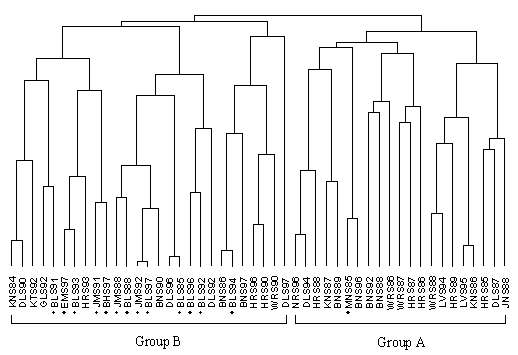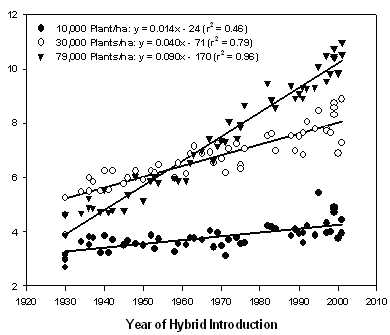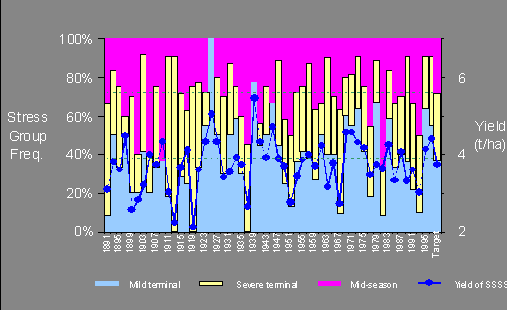Australia
May 2, 2005
|
Title |
Prospects for increasing
yield in Sorghum by breeding |
|
Description |
Research Update for
Growers - Northern Region - March 2005 |
|
GRDC Projects* |
DAQ00076 and DAQ00015 |
|
Author |
David Jordan, Department
Primary Industries and fisheries, Warwick Qld
Ph: 07 4660 3622, Email:
david.r.jordan@dpi.qld.gov.au |
|
Presented |
Goondiwindi, QLD
|
Take home messages:
- Since the introduction of
hybrids in the 1950s the rate of genetic progress for grain
yield has been slow (<1% per year) and in recent years this
rate has plataued.
- Causes of slow progress
include low genetic diversity, genotype x environment
interactions that complicate selection and a focus on
defensive traits.
- A combination of the
maturing of new technologies and new investment by GRDC and
DPI&F offer promise for increasing yield by breeding. The
development of sorghum hybrids with some degree of
adaptation to specific environment types is likely to be an
important part of any progress.
Background
GRDC and the Queensland
government jointly fund the DPI&F breeding program, which is the
only publicly funded sorghum-breeding program in Australia. The
current role of the program is to address strategic industry
issues through the development of germplasm and by facilitating
R&D. DPI&F no longer develops or evaluates commercial hybrids
rather it generates germplasm lines whose benefits are delivered
to grain growers via the private seed companies. The breeding
program has a long history of developing lines with midge
resistance and more recently stay-green. Lately with new
investment from GRDC and DPI&F the focus of the program has
changed to increasing grain yield via breeding while maintaining
acceptable levels of midge resistance and stay-green. This
update reports on aspects of current research in the program and
its potential increasing sorghum yields by breeding.
Grain yield
Since the introduction of
hybrids in the 1950s the rate of genetic progress for grain
yield has been slow (<1% per year) and this slow rate of
progress has plateaued. The causes of this slow rate of progress
are low levels of genetic diversity in elite sorghum, a strong
focus on breeding for defensive traits and genotype by
environment interactions that complicate selection. DPI&F is
using three strategies to improve sorghum yield.
1) Increasing genetic
diversity
The genetic diversity of
Australian elite sorghum is relatively low and is potentially
reducing progress for grain yield. The DPI&F sorghum-breeding
program has a large Bring in genetic diversity while maintaining
current levels of midge resistance and stay-green. The program
consists of identify useful germplasm from around the world and
using it to produce populations with good levels of midge
resistance and stay-green. Progress to date has been promising.
2) Trait based breeding
The program is working on
specific traits though have the potential to increase yield in
Australian environments. Stay-green is a good example of this
trait-based approach. Stay-green results in increased grain
yield when crops are subject to water stress after flowering.
Height in sorghum is strongly correlated with grain yield with
taller sorghum varieties yielding more on average than short
ones. Tall genotypes have a greater tendency to lodge and
sorghum breeders have generally selected for shorter types. The
improvement in standability that has occurred as a result of
stay-green may allow taller higher yielding sorghums to be
developed.
3) Specific adaptation
In Australia, there has been a
tendency to develop sorghum hybrids with broad adaptation to a
range of climatic conditions. The development of sorghum hybrids
with specific adaptation to particular types of
environments/management systems offers the potential to enhance
yield. These types of systems include low rainfall skip row
systems and high rainfall high yield systems. Recent advances in
plant physiological modelling and molecular marker technology
offer greater scope to develop sorghum hybrids that are suited
to particular production/management environments.
|
Figure 1 : Classification
Of 43 DPI&F sorghum trials based on relative hybrid
ranking |
 |
Group B
= CQ & Dry southern environments,
Group A= low stress environments |
| |
|
Table 1 : Correlations
between yield, stay-green and height (43 breeding
trials) |
 |
| |
Yield improvement in maize
a success story
Duvick et al |
 |
| |
|
Sorghum environment types
(Chapman et al) |
 |
Disclaimer
Any recommendations, suggestions or opinions contained in this
publications do not necessarily represent the policy or views of
the Grains Research and Development Corporation. No person
should act on the basis of the contents of this publication
without first obtaining specific, independent professional
advice. The Grains Research and Development Corporation will not
be liable for any loss, damage, cost or expense incurred or
arising by reason of any person using or relying on the
information in this publication.
|